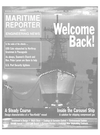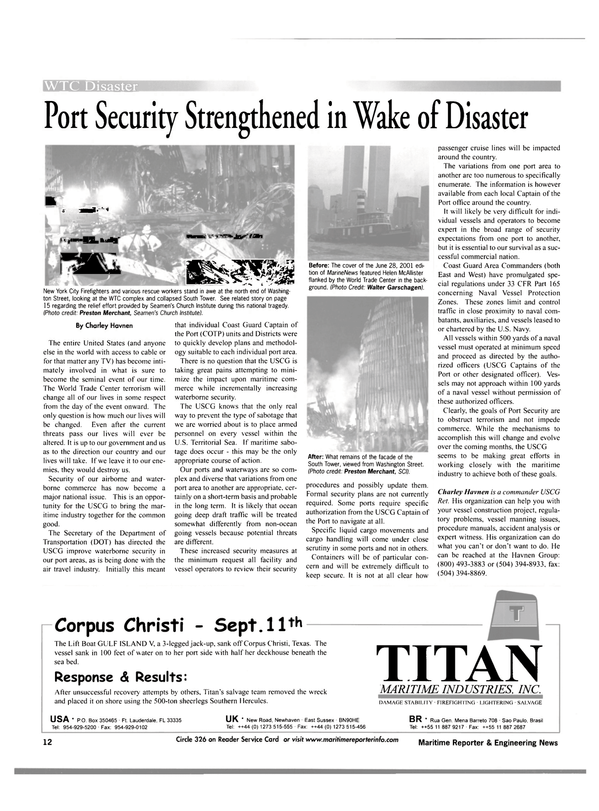
Port Security Strengthened in Wake of Disaster
The entire United States (and anyone else in the world with access to cable or for that matter any TV) has become intimately involved in what is sure to become the seminal event of our time.
The World Trade Center terrorism will change all of our lives in some respect from the day of the event onward. The only question is how much our lives will be changed. Even after the current threats pass our lives will ever be altered. It is up to our government and us as to the direction our country and our lives will take. If we leave it to our enemies.
they would destroy us.
Security of our airborne and waterborne commerce has now become a major national issue. This is an opportunity for the USCG to bring the maritime industry together for the common good.
The Secretary of the Department of Transportation (DOT) has directed the USCG improve waterborne security in our port areas, as is being done with the air travel industry. Initially this meant that individual Coast Guard Captain of the Port (COTP) units and Districts were to quickly develop plans and methodology suitable to each individual port area.
There is no question that the USCG is taking great pains attempting to minimize the impact upon maritime commerce while incrementally increasing waterborne security.
The USCG knows that the only real way to prevent the type of sabotage that we are worried about is to place armed personnel on every vessel within the U.S. Territorial Sea. If maritime sabotage does occur - this may be the only appropriate course of action.
Our ports and waterways are so complex and diverse that variations from one port area to another are appropriate, certainly on a short-term basis and probable in the long term. It is likely that ocean going deep draft traffic will be treated somewhat differently from non-ocean going vessels because potential threats are different.
These increased security measures at the minimum request all facility and vessel operators to review their security procedures and possibly update them.
Formal security plans are not currently required. Some ports require specific authorization from the USCG Captain of the Port to navigate at all.
Specific liquid cargo movements and cargo handling will come under close scrutiny in some ports and not in others.
Containers will be of particular concern and will be extremely difficult to keep secure. It is not at all clear how passenger cruise lines will be impacted around the country.
The variations from one port area to another are too numerous to specifically enumerate. The information is however available from each local Captain of the Port office around the country.
It will likely be very difficult for individual vessels and operators to become expert in the broad range of security expectations from one port to another, but it is essential to our survival as a successful commercial nation.
Coast Guard Area Commanders (both East and West) have promulgated special regulations under 33 CFR Part 165 concerning Naval Vessel Protection Zones. These zones limit and control traffic in close proximity to naval combatants, auxiliaries, and vessels leased to or chartered by the U.S. Navy.
All vessels within 500 yards of a naval vessel must operated at minimum speed and proceed as directed by the authorized officers (USCG Captains of the Port or other designated officer). Vessels may not approach within 100 yards of a naval vessel without permission of these authorized officers.
Clearly, the goals of Port Security are to obstruct terrorism and not impede commerce. While the mechanisms to accomplish this will change and evolve over the coming months, the USCG seems to be making great efforts in working closely with the maritime industry to achieve both of these goals.
Cliurley Havnen is a commander USCG Ret. His organization can help you with your vessel construction project, regulatory problems, vessel manning issues, procedure manuals, accident analysis or expert witness. His organization can do what you can't or don't want to do. He can be reached at the Havnen Group: (800) 493-3883 or (504) 394-8933, fax: (504) 394-8869.
Read Port Security Strengthened in Wake of Disaster in Pdf, Flash or Html5 edition of October 2001 Maritime Reporter
Other stories from October 2001 issue
Content
- Gratingless Air Circ System in Reefer Ships page: 44A
- New Technology To Debut At Europort page: 44B
- AIS: T h e Future is N ow page: 44F
- NOL Reports First Half Profit of $1M page: 4
- Speechless page: 6
- John Deere Offers N ew 3 0 0 HP Engine page: 7
- Now the Carousel Ship page: 8
- Port Security Strengthened in Wake of Disaster page: 12
- A Race With A Meaning ... Before the Fall of the Towers page: 14
- SCI: Disaster Relief on the Fly page: 15
- Following Wake of Terrorist Attacks, USS Cole is Relaunched page: 18
- INTERTANKO Offers Support, Vital Information During National Tragedy page: 19
- G O M Softness Drives GLM Score Down page: 20
- All-Purpose Aid And Hospital Vessel Delivered page: 21
- ASRY's Services Are In High Demand page: 23
- Rolf To The Rescue: German Yard Delivers Aluminum Rescue Launch page: 25
- Fusion Polycraft's RIB Designed To Be Indestructible page: 25
- Sea-Kindly: A Steady Vessel by Design page: 26
- New Inland Containership Concept Unveiled page: 30
- High-Tech Service Initiatives From Deltamarin page: 32
- FORAN v50: A Technological Renovation page: 36
- N a p a O y Opens Office In Japan page: 38
- NUPAS-Cadmatic Offers V4.3 page: 40
- Ship Evac Simulation Software Shows Promise page: 42
- Wartsila s Dual-Fuel Engine Power Module For FPSO Upgrade page: 44
- Euroferrys' Fast Ferry Features Cat 3618 Power page: 46
- PRI Fuel Treatment Helps Meet Emissions Challeng es page: 47
- Western Towboat Gets A N e w Titan page: 48
- Nichols Bros. To Construct Powerful Fireboat page: 50
- Statoil Ships Run on Gas... Liquefied Natural Gas That Is page: 51
- W Q I S Broadens Coverage To Meet State Requirements page: 52
- Wartsila Wins Environmental Award page: 53
- Pumping Ballast for Ocean-Going Barges page: 54
- Self-Cleaning Filter System Cuts Maintenance Costs page: 60
- CMP Packs Decade of Tin-Free Experience page: 62
- MarineLine Boosts C l e a r w a t e r ' s Profitability page: 64
- Dampney Manufactures Advanced Coatings page: 67
- W a r t s i l a Engines To Power Queen M a r y 2 page: 70
- Keppel Hitachi Zosen Delivers Semi-tender Rig page: 73


